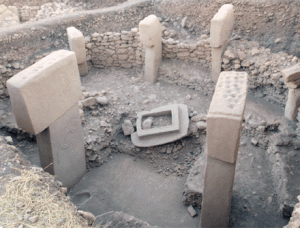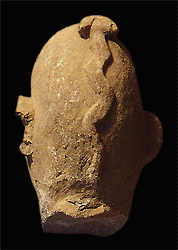A Light At The Edge of Civilization

You may already be familiar with the ancient ruins of Gobekli Tepe, but you may not have heard of the nearby site of Nevali Cori, which has received little press. It dates from about 8000 BC and is now submerged under water. Nevali Cori was an established village that continues the pillar cult of Gobekli Tepe, only it places the pillars inside an indoor temple. The sculpted art that is associated with this site is hair-raising: women being carried away by raptors; the earliest depiction of a kundalini serpent going up the back of a man’s head (photo below); half-human, half-bird men with sinister-looking faces.
I love to imagine the lives of the people who worshiped at these sites – so ancient are these places that it is assumed the people who created them were still in the hunger-gatherer phase of civilization. But Analysis of the seeds discovered from the site shows that farming in the form of domesticated wheat was practised at Nevali Cori as early as 7,200 BC – This confounds established science. Clearly these humans were not only farming, but they were advanced stone masons and masters of temple building. Not only that, but their spiritual knowledge appears to have been vast and their artistic skills were highly developed.
If they were merely hunter-gatherers on the dark edge of civilization, how then were they able to feed and manage the countless teams of people it must have taken to create these structures? How were the stones moved? What previous and even older civilizations had these people emerged from and how advanced were those civilizations?
For more on Nevali Cori click here. For more on Gobekli Tepe, here.
Share


Mary Anne Graham on 11 Jul 2011 at 5:15 pm #
Hi MJ!
I found your blog through the interview on Konrath’s blog – (A Newbie’s Guide To Publishing).
These ancient sites are fascinating. It seems that the more we learn about history, the less we know. But that’s more fun, in a way. Like you say, we can look at a piece of pottery or a ceremonial relic and create our own stories around them. I bet the artists and artisans would appreciate that their work still holds so much creative force.
If you’re a writer, composing a story based on how you see something – anything – seems to be pretty much standard, doesn’t it? I often watch a cliffhanger on TV and go to sleep conjuring how I’d have it end.
I also wanted to stop by and say THANKS. You blazed a trail that I and many other indie authors are now following. It seems that your hard work paid off and that you’re reaping some of the rewards of the success you’ve earned.
admin on 13 Jul 2011 at 3:23 pm #
Thank you for your kind words and for reading the blog! I will make sure MJ reads your comment.
-Emily, blog editor
Museum of Mysteries » Göbekli Tepe: A Sign of “Civilization One”? on 03 Oct 2011 at 11:14 am #
[…] A riveting History Channel piece on the mystery of 12,000 year old Gobekli Tepe (we’ve blogged on this incredible ancient find, here.) […]